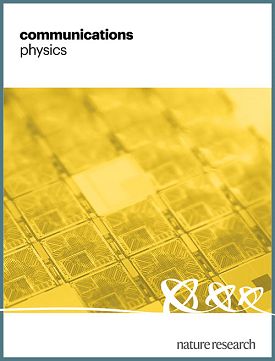Reservoir direct feedback alignment: deep learning by physical dynamics
IF 5.4
1区 物理与天体物理
Q1 PHYSICS, MULTIDISCIPLINARY
引用次数: 0
Abstract
The rapid advancement of deep learning has motivated various analog computing devices for energy-efficient non-von Neuman computing. While recent demonstrations have shown their excellent performance, particularly in the inference phase, computation of training using analog hardware is still challenging due to the complexity of training algorithms such as backpropagation. Here, we present an alternative training algorithm that combines two emerging concepts: reservoir computing (RC) and biologically inspired training. Instead of backpropagated errors, the proposed method computes the error projection using nonlinear dynamics (i.e., reservoir), which is highly suitable for physical implementation because it only requires a single passive dynamical system with a smaller number of nodes. Numerical simulation with Lyapunov analysis showed some interesting features of our proposed algorithm itself: the reservoir basically should be selected to satisfy the echo-state-property; but even chaotic dynamics can be used for the training when its time scale is below the Lyapunov time; and the performance is maximized near the edge of chaos, which is similar to standard RC framework. Furthermore, we experimentally demonstrated the training of feedforward neural networks by using an optoelectronic reservoir computer. Our approach provides an alternative solution for deep learning computation and its physical acceleration. Existing training algorithms for deep neural networks are not suitable for energy-efficient analog hardware. Here, the authors propose and experimentally demonstrate an alternative training algorithm based on reservoir computing, which improves training efficiency in optoelectronic implementations.

储层直接反馈对准:物理动力学深度学习
深度学习的快速发展推动了各种模拟计算设备的节能非冯·诺伊曼计算。虽然最近的演示显示了它们的优异性能,特别是在推理阶段,但由于训练算法(如反向传播)的复杂性,使用模拟硬件进行训练的计算仍然具有挑战性。在这里,我们提出了一种替代训练算法,它结合了两个新兴概念:储层计算(RC)和生物启发训练。该方法使用非线性动力学(即储层)计算误差投影,而不是反向传播误差,这非常适合物理实现,因为它只需要一个节点数量较少的单一被动动力系统。Lyapunov分析的数值模拟显示了本文算法本身的一些有趣的特点:水库的选择基本上要满足回声状态属性;但当时间尺度低于李雅普诺夫时间时,甚至可以使用混沌动力学进行训练;在混沌边缘附近性能最大化,这与标准RC框架相似。此外,我们还通过实验证明了利用光电水库计算机对前馈神经网络进行训练。我们的方法为深度学习计算及其物理加速提供了另一种解决方案。现有的深度神经网络训练算法不适合高能效的模拟硬件。在此,作者提出并实验证明了一种基于储层计算的替代训练算法,该算法提高了光电实现中的训练效率。
本文章由计算机程序翻译,如有差异,请以英文原文为准。
求助全文
约1分钟内获得全文
求助全文
来源期刊

Communications Physics
Physics and Astronomy-General Physics and Astronomy
CiteScore
8.40
自引率
3.60%
发文量
276
审稿时长
13 weeks
期刊介绍:
Communications Physics is an open access journal from Nature Research publishing high-quality research, reviews and commentary in all areas of the physical sciences. Research papers published by the journal represent significant advances bringing new insight to a specialized area of research in physics. We also aim to provide a community forum for issues of importance to all physicists, regardless of sub-discipline.
The scope of the journal covers all areas of experimental, applied, fundamental, and interdisciplinary physical sciences. Primary research published in Communications Physics includes novel experimental results, new techniques or computational methods that may influence the work of others in the sub-discipline. We also consider submissions from adjacent research fields where the central advance of the study is of interest to physicists, for example material sciences, physical chemistry and technologies.
 求助内容:
求助内容: 应助结果提醒方式:
应助结果提醒方式:


